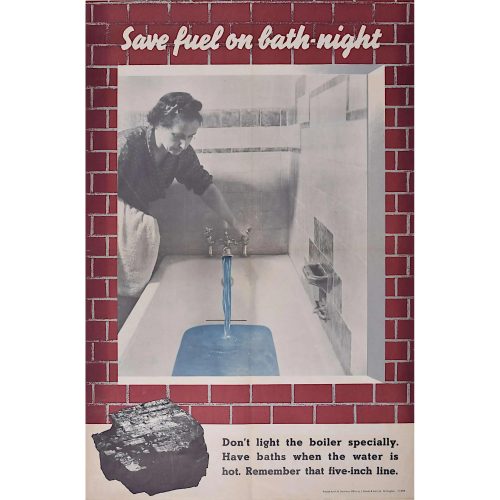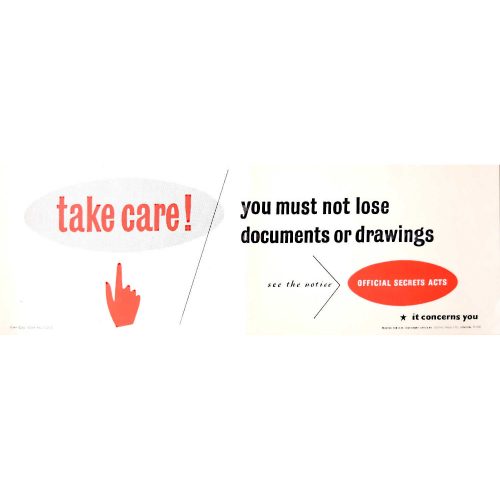-

Keep It Dark (1939 - 1945)
Lithographic poster 25 x 31 cm Sponsored by Her Majesty's Stationery Office; printed by Perry Colourprint. A copy of this poster is held by the Imperial War Museum. This poster, bearing lyrics designed to be sung to the tune of "She'll be coming round the mountain", was designed for the Ministry of Information during the Second World War. It urges the population to avoid talking carelessly about details of Britain's operational movements, which might unwittingly end up in the wrong hands. Condition: good. Some small losses to extreme margins. If you’d like to know more, please email info@manningfineart.co.uk or call us on 07929 749056. -

Cyril Kenneth Bird ‘Fougasse’ (1887 - 1965)
Careless Talk Costs Lives (circa 1940)
Lithographic poster 32 x 20 cm (12.5 x 8 in) Version printed on thinner paper. Fougasse was a British cartoonist. He was art editor of Punch between 1937 and 1949, and subsequently editor until 1953. He is best known for his ‘Careless Talk Costs Lives’ series of posters, and the other posters for the Ministry of Information and London Transport. As the Second World War progressed, the Ministry of Information’s poster campaign had become less and less effective. There were posters instructing the population to save old clothes for rags, turn off the lights, save food, dig for victory, watch out for spies, and keep calm and carry on. With this instruction overload, the population had ceased paying attention to the posters. Fougasse noticed this, and offered his services unpaid to the Ministry of Information, with a view to bringing a touch of humour to the posters. His amusing designs with pithy captions, reminiscent of newspaper cartoons, helped to get the Ministry's messages across in a novel way. Fougasse's distinctive poster style, with the red border, was subsequently adopted by other Ministry artists. Condition: if you’d like to know more, please email info@manningfineart.co.uk or call us on 07929 749056. -

Cyril Kenneth Bird ‘Fougasse’ (1887 - 1965)
Careless Talk Costs Lives (circa 1940)
Lithographic poster 32 x 20 cm (12.5 x 8 in) Version printed on thinner paper. Fougasse was a British cartoonist. He was art editor of Punch between 1937 and 1949, and subsequently editor until 1953. He is best known for his ‘Careless Talk Costs Lives’ series of posters, and the other posters for the Ministry of Information and London Transport. As the Second World War progressed, the Ministry of Information’s poster campaign had become less and less effective. There were posters instructing the population to save old clothes for rags, turn off the lights, save food, dig for victory, watch out for spies, and keep calm and carry on. With this instruction overload, the population had ceased paying attention to the posters. Fougasse noticed this, and offered his services unpaid to the Ministry of Information, with a view to bringing a touch of humour to the posters. His amusing designs with pithy captions, reminiscent of newspaper cartoons, helped to get the Ministry's messages across in a novel way. Fougasse's distinctive poster style, with the red border, was subsequently adopted by other Ministry artists. Condition: if you’d like to know more, please email info@manningfineart.co.uk or call us on 07929 749056. -
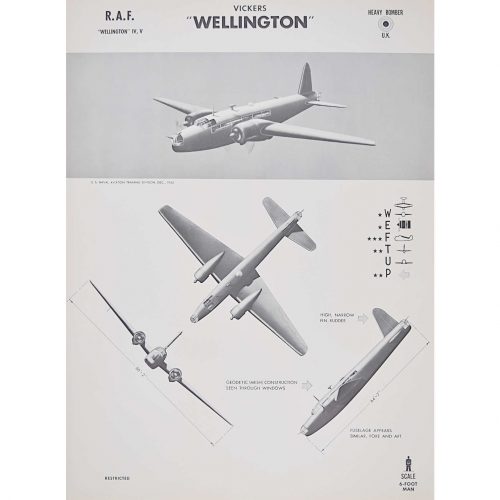
US Naval Aviation Training Division
Vickers Wellington
Aeroplane identification poster, 1942 63 x 47 cm A particularly unusual style of aeroplane identification poster, owing to the very arty images. Most such posters rely on very plain silhouettes, this series - and we have several in this series; view them here - have a much more arty approach to the task with shading and an interesting angle view. The Vickers Wellington was a British twin-engined, long-range medium bomber. It was designed during the mid-1930s at Brooklands in Weybridge, Surrey. Led by Vickers-Armstrongs' chief designer Rex Pierson; a key feature of the aircraft is its geodetic airframe fuselage structure, which was principally designed by Barnes Wallis. Development had been started in response to Air Ministry Specification B.9/32, issued in the middle of 1932, for a bomber for the Royal Air Force. This specification called for a twin-engined day bomber capable of delivering higher performance than any previous design. Other aircraft developed to the same specification include the Armstrong Whitworth Whitley and the Handley Page Hampden. During the development process, performance requirements such as for the tare weight changed substantially, and the engine used was not the one originally intended. The Wellington was used as a night bomber in the early years of the Second World War, performing as one of the principal bombers used by Bomber Command. During 1943, it started to be superseded as a bomber by the larger four-engined "heavies" such as the Avro Lancaster. The Wellington continued to serve throughout the war in other duties, particularly as an anti-submarine aircraft. It holds the distinction of having been the only British bomber that was produced for the duration of the war, and of having been produced in a greater quantity than any other British-built bomber. The Wellington remained as first-line equipment when the war ended, although it had been increasingly relegated to secondary roles. The Wellington was one of two bombers named after Arthur Wellesley, 1st Duke of Wellington, the other being the Vickers Wellesley. A larger heavy bomber aircraft designed to Specification B.1/35, the Vickers Warwick, was developed in parallel with the Wellington; the two aircraft shared around 85% of their structural components. Many elements of the Wellington were also re-used in a civil derivative, the Vickers VC.1 Viking. If you are interested, please email info@manningfineart.co.uk or call us on 07929 749056. -
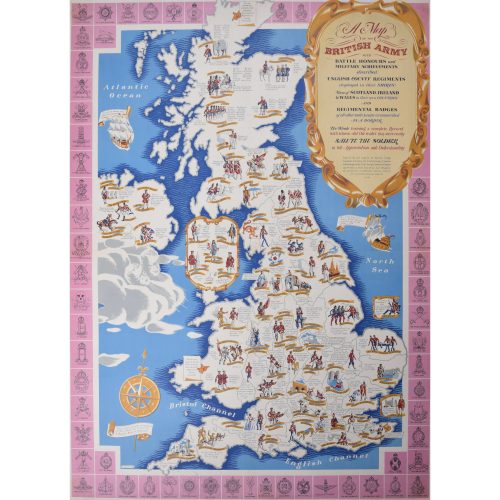
Charles Paine (1895-1967)
Army Map of England (1944)
Lithograph 99 x 75 cm Published for the National Savings Committee in London, the Scottish Savings Committee in Edinburgh, and the Ulster Savings Committee in Belfast. Printed at Field Sons & Co. Ltd., Bradford, for His Majesty's Stationery Office, London. Signed lower left in the plate. Charles Paine was a versatile and prolific designer, who drew on his training in stained glass to create bold, structured and highly stylised lithographs for a variety of companies. This decorative and brightly-coloured map illustrates the various county regiments of Great Britain, with a border of regimental badges. If you’d like to know more, please email info@manningfineart.co.uk or call us on 07929 749056. -
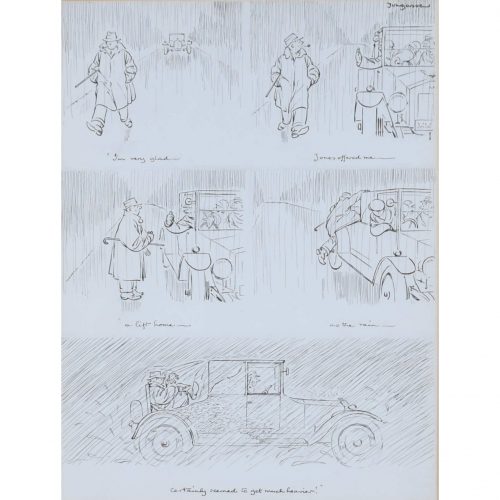
Fougasse (Cyril Kenneth Bird, 1887 - 1965)
'I'm very glad Jones offered me a lift home as the rain certainly seemed to get much heavier!' (1966)
Pen and ink 32 x 24 cm Signed upper right. Cyril Kenneth Bird, under the name Fougasse, was a British cartoonist. He was art editor of Punch 1937 - 1949, and subsequently editor until 1953. He is best known for his ‘Careless Talk Costs Lives’ series of posters, and produced many other posters for the Ministry of Information and London Underground. His pen and ink cartoons for Punch are some of his gentlest and funniest works. Provenance: The Fine Art Society Ltd., 148 New Bond Street, June 1966. If you’d like to know more, please email info@manningfineart.co.uk or call us on 07929 749056. -
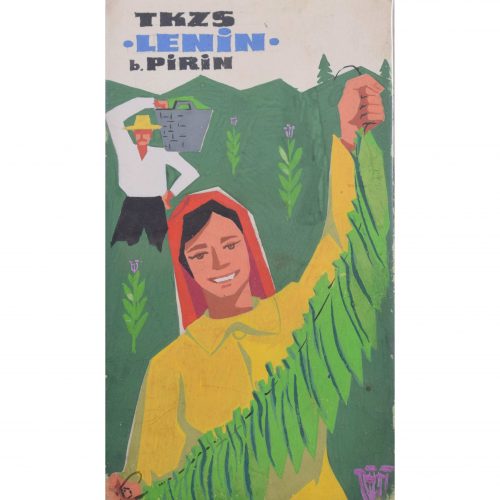
Soviet Union pro-Lenin Marxist Bulgarian propaganda poster design (circa 1950s)
Gouache on board 20 x 11.5 cm After a Communist takeover in 1945, Bulgaria was a Soviet ally during the Cold War, and maintained good relationships with Russia until the Revolutions of 1989. From 1945 to 1948, the country became entrenched within the Soviet sphere of influence under the control of the Bulgarian Communist Party (BCP) which oversaw a program of Stalinization in the late 1940s and 1950s. Both countries are Slavic nations, and are bound together by a common Orthodox Christian culture. This poster design is a piece of Leninist propaganda, designed to make Bulgarians associate Lenin and Soviet Marxist rule with efficiency and plenty. It is inscribed to the reverse in Bulgarian 'To grow plants in rows next to each other - the thickest row with straight cobs'. The Pirin Mountains referred to in the top left-hand corner are a mountain range in southwestern Bulgaria. Condition: very good. If you’d like to know more, please email info@manningfineart.co.uk or call us on 07929 749056. -
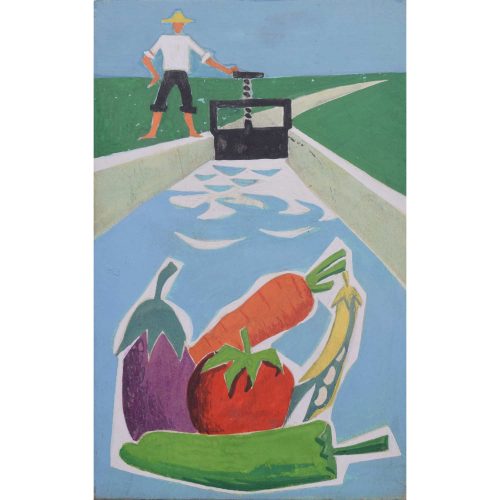
Soviet Union socialist irrigation Bulgarian propaganda poster design (circa 1950s)
Gouache on board 18 x 11 cm After a Communist takeover in 1945, Bulgaria was a Soviet ally during the Cold War, and maintained good relationships with Russia until the Revolutions of 1989. From 1945 to 1948, the country became entrenched within the Soviet sphere of influence under the control of the Bulgarian Communist Party (BCP) which oversaw a program of Stalinization in the late 1940s and 1950s. Both countries are Slavic nations, and are bound together by a common Orthodox Christian culture. This poster design features huge juicy vegetables, grown as the result of newly-implemented irrigation systems. Socialist farming practices in Bulgaria were commonplace during its time as a Soviet ally or 'satellite'; the government was keen to encourage well-yielding farming practices and to be seen as a protector of agricultural infrastructure turing this turbulent period of the 20th century. Condition: very good. If you’d like to know more, please email info@manningfineart.co.uk or call us on 07929 749056. -
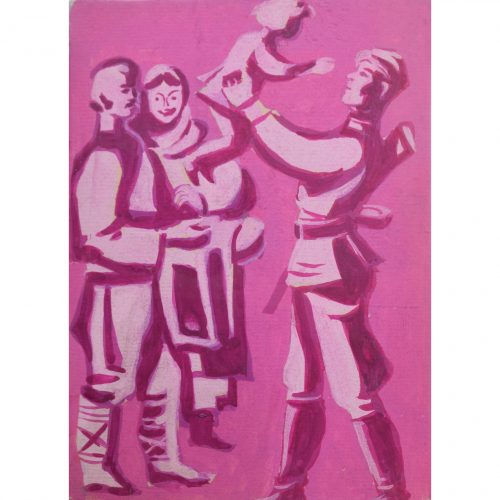
Bulgarian pro-natalist propaganda poster design (circa 1950s)
Gouache on board 17 x 12 cm After a Communist takeover in 1945, Bulgaria was a Soviet ally during the Cold War, and maintained good relationships with Russia until the Revolutions of 1989. From 1945 to 1948, the country became entrenched within the Soviet sphere of influence under the control of the Bulgarian Communist Party (BCP) which oversaw a program of Stalinization in the late 1940s and 1950s. Both countries are Slavic nations, and are bound together by a common Orthodox Christian culture. This poster design, painted in warm pink-purple tones and depicting a Bulgarian soldier holding a toddler aloft, was designed as post-war pro-natalist propaganda (likely from the 1950s). Bulgaria and its Soviet allies had lost a huge number of men during the war, and this design for a poster was intended to encourage Bulgarians to have more children. Condition: very good. If you’d like to know more, please email info@manningfineart.co.uk or call us on 07929 749056. -
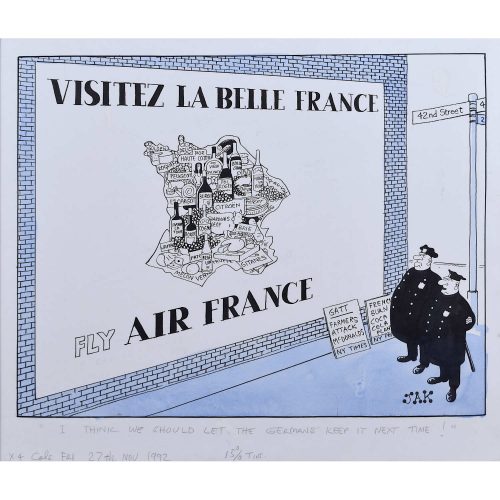
JAK (Raymond Allen Jackson) 1927-1997
"I think we should let the Germans keep it next time" (1992)
Visitez La Belle France, Fly Air France 51x59cm Pen, ink and monochrome wash with inscriptions in pencil. For the London Evening Standard JAK was one of Britian's best-known political cartoonists, working for the London Evening Standard and the Daily Mail between the 1950s and 1990s. He left school at the age of 14, and after a brief career as a messenger boy studied at Willesden College of Technology, studying art with the aim of becoming an art teacher. Following National Service (in the Territorial Army, teaching conscripts to paint), in 1950 he became a staff artist at Link House Publications, and then at advertising agency J Keymer & Co. Whilst working here he submitted cartoons to Punch and other journals, joining the Evening Standard in 1952 as illustrator, also drawing occasional cartoons. In 1966, following the suicide of 'Vicky' (Victor Weisz), he became policital cartoonist at the Evening Standard. Some of his cartoons were highly controversial. In 1970 he caricatured power workers (then striking to improve their conditions) as stupid, greedy and deaf to reason; the entire Evening Standard staff nearly went on strike in response. In 1982 a cartoon in response to the Northern Ireland situation (he frequently depicted Irish people negatively) caused Ken Livingstone to withdraw all advertising from the Standard. His style was distinctive, drawn in ink on 17" x 21.5" board using a mapping pen and brush. His signature was always in a bottom corner, with blob-like serifs, and the title and other instructions were drawn on the picture in pencil. He also drew cartoons for the Mail on Sunday, Daily Express, and Sunday Express. -
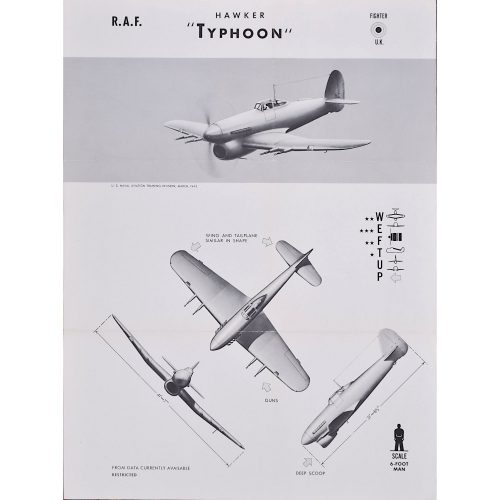
US Naval Aviation Training Division
RAF Hawker Typhoon World War 2 US airplane
Original aeroplane identification poster, 1942 63x47cm A particularly unusual style of aeroplane identification poster, owing to the very arty images. Most such posters rely on very plain silhouettes, this series - and we have several in this series (click here) - have a much more arty approach to the task with shading and an interesting angle view. The Typhoon is a single-seat fighter-bomber nicknamed the 'Tiffy'. Designed as a replacement for the Hawker Hurricane it never completely satisfied this expectation. However it was the only RAF fighter capable of catching the Fw 190 at low altitudes when the latter came into service in 1941. It became one of the most effective ground-attack aircraft of the Second World War. 3317 were produced and only one complete Typhoon still exists which belongs to the Royal Air Force Museum in Hendon. If you are interested email info@manningfineart.co.uk or call us on 07929 749056. -
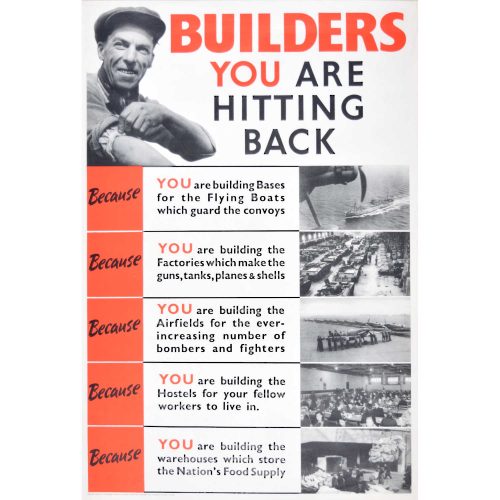
Builders YOU Are Hitting Back Original WW2 Poster (c.1940)
'Builders - YOU Are Hitting Back' Original WW2 Poster (c.1940) 76 x 50.5 cm Lithograph and letterpress (on paper) Printed by Lowe and Brydone Printers Ltd, London NW10. Published by HM Stationery Office. Because: You are building bases for the Flying Boats which guard the convoys You are building the Factories which makes the guns, tanks, planes & shells You are building the Airfields for the ever increasing number of bombers and fighters - Spitfire You are building the Hostels for your fellow workers to live in You are building the warehouses which store the Nation's Food Supply -
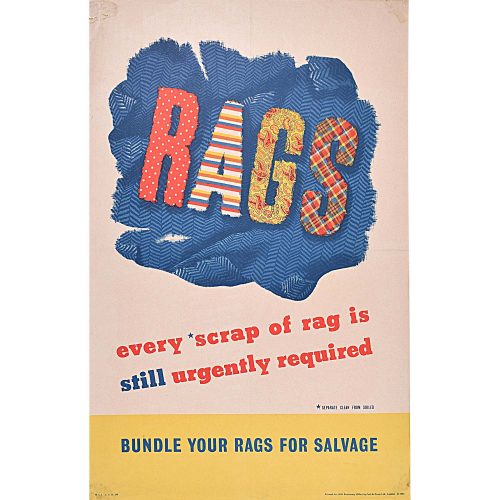
Anonymous
Rags Every bit of rag still urgently required
WW2 British Home Front Poster 75x49cm Lithograph in four colours If you are interested email info@manningfineart.co.uk or call us on 07929 749056. Condition: Good. -
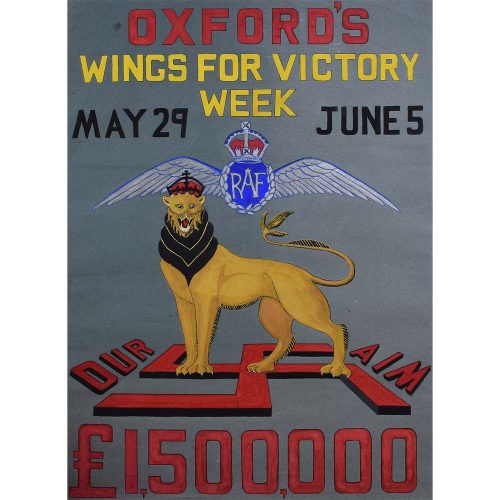
Anonymous
Oxford Wings for Victory Poster Design IV
c.1943 Gouache on paper 70 x 51 cm 89 x 68 cm including hand-finished frame, UK shipping only Click here to see other posters from this series. If you are interested email info@manningfineart.co.uk or call us on 07929 749056. Condition: Excellent.

